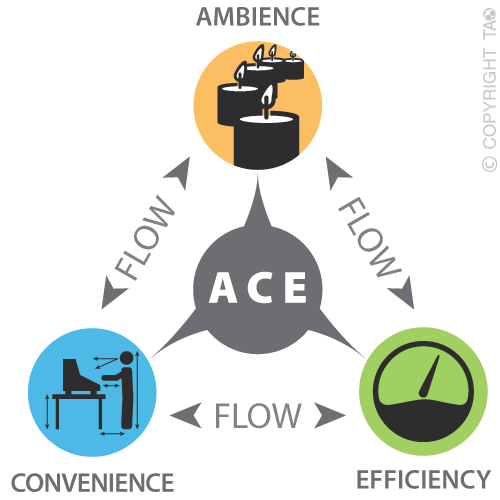ACE
Ambience, Convenience and Efficient –ACE Model

TAO, with in depth experience of working in factories and design of factories, have developed a model ACE that can be generically used to design new factories.
Factories are where the employees spend about 1/3rd of their daily life. So the thought is provide the employees with pleasant workspaces and ergonomic workstations so that they would love to come to work, are optimally productive with high value adding capability.
So how do you even start the design for a new facility? Yes one does have the process flow and historical data on factories done before and layouts that one may copy paste it with improvements based on pain areas and other incremental inputs. Will that give a super factory, maybe yes if the earlier factory itself js world class and even then it will be necessary to work in a systematic way to create always a factory for the future, as by the time the factory evolves technology changes.
In any factory the movement and interaction of people is intertwined with storage/ movement of materials and operating of equipment that process the material. So in order to optimize the people flow, the material flow and process flow TAO has developed the ACE model that enables facility planners and project team to design the factory layout that will enable desired and sustainable high performance with vibrancy.
The ACE model is a comprehensive yet simplistic way to design the layout of a facility that forms the base document or brief to an architect to design the factory building in a cost and yet elegant way. The unique approach is to define the function and with the architect design the building and campus in a way that enhances function.

The ACE model is applied in an interface matrix covering all sections in factory on three principles of:
- People flow
- Process flow
- Material flow
and the points expressed or stated will be the inputs for detailed design of facilities and layout leading to an outcome that can be measured in terms of :
- Resource optimization-space productivity
- People productivity
- Process Improvements and connections
- Energy conservation
- Services arrangement close to point of contact and associations
- Optimal capital costs and low running costs
- Eco efficiency
- Good Manufacturing Practice
- Statutory Compliance
- Visual Vibrant Spaces
Ambience, Convenience and Efficient –ACE Model

TAO, with in depth experience of working in factories and design of factories, have developed a model ACE that can be generically used to design new factories.
Factories are where the employees spend about 1/3rd of their daily life. So the thought is provide the employees with pleasant workspaces and ergonomic workstations so that they would love to come to work, are optimally productive with high value adding capability.
So how do you even start the design for a new facility? Yes one does have the process flow and historical data on factories done before and layouts that one may copy paste it with improvements based on pain areas and other incremental inputs. Will that give a super factory, maybe yes if the earlier factory itself js world class and even then it will be necessary to work in a systematic way to create always a factory for the future, as by the time the factory evolves technology changes.
In any factory the movement and interaction of people is intertwined with storage/ movement of materials and operating of equipment that process the material. So in order to optimize the people flow, the material flow and process flow TAO has developed the ACE model that enables facility planners and project team to design the factory layout that will enable desired and sustainable high performance with vibrancy.
The ACE model is a comprehensive yet simplistic way to design the layout of a facility that forms the base document or brief to an architect to design the factory building in a cost and yet elegant way. The unique approach is to define the function and with the architect design the building and campus in a way that enhances function.

The ACE model is applied in an interface matrix covering all sections in factory on three principles of:
- People flow
- Process flow
- Material flow
and the points expressed or stated will be the inputs for detailed design of facilities and layout leading to an outcome that can be measured in terms of :
- Resource optimization-space productivity
- People productivity
- Process Improvements and connections
- Energy conservation
- Services arrangement close to point of contact and associations
- Optimal capital costs and low running costs
- Eco efficiency
- Good Manufacturing Practice
- Statutory Compliance
- Visual Vibrant Spaces

